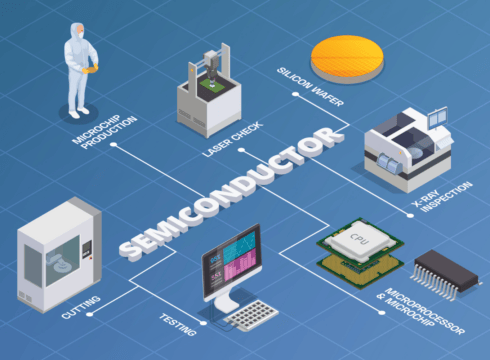India’s semiconductor industry is projected to achieve a market value of $55 Bn by 2026
ARM is reshaping chip design by licensing its IP to manufacturers for further development and production in foundries
As artificial intelligence grows at an unprecedented pace, it will also play a revolutionary role in transforming the chip ecosystem
Inc42 Daily Brief
Stay Ahead With Daily News & Analysis on India’s Tech & Startup Economy
Over the years, semiconductor chips have caused a massive disruption in every facet of the industrial landscape, navigating beyond a mere tool to becoming the building blocks of all sectors of the economy.
Standing at the threshold of digitisation and innovation, India’s semiconductor industry is projected to achieve a market value of $55 Bn by 2026. Driven by the demand for smartphones, automobiles and data storage, Semiconductor chips will continue to penetrate deep into the peripherals of India’s aerospace, automobile, communication, IT, clean energy, defence and other sectors.
Poised to drive the next phase of the digital revolution under the illustrious Industry 4.0, India’s semiconductor chip landscape is actively undergoing a wave of paradigm shifts.
With transformation at the forefront, this ground-breaking revolution will be characterised by advancements in architecture, materials, AI, 3D technologies, memory systems, and the integration of CMOS and MEMS.
As we progress further, the future of chip manufacturing promises unparalleled efficiency and innovation, solidifying India’s position as a ‘Semiconductor Superpower’.
New Chip Architectures In The Market
For over five decades, the X86 architecture has been the bedrock of the microprocessor industry. However, in recent times, the industry has witnessed a change with ARM architecture making significant strides in the market.
Noted for its impressive performance and low electricity consumption, ARM is reshaping chip design by licensing its IP to manufacturers for further development and production in foundries.
Boasting a RISC-V architecture, being open-source and energy-efficient, it is increasingly becoming prevalent in IoT devices and other applications.
Dynamic Material To Complement Silicone Base
Although silicone has been the standard base material for microchips for a long time, recently it has reached its performance limit, leading the industry on a quest for smaller, faster and integrated circuits.
The exploration for emerging materials, namely gallium nitride, commonly used in power grids for effective power conversion also contributed to the need for improvised circuits.
Microchips leveraging antimony and bismuth are proactively enhancing infrared sensors in medical and military sectors. Graphene possesses the potential to outdo silicone, though its widespread commercialization is years away.
Furthermore, pyrite is also emerging as a viable substitute for rare earth elements in solar cells, offering an abundant, economical and non-toxic alternative.
Embracing Smart Technologies: Artificial Intelligence’s Edge
As artificial intelligence grows at an unprecedented pace, it will also play a revolutionary role in transforming the chip ecosystem. By embedding learned knowledge in IoT endpoints, AI chips are achieving much better efficiencies.
However, to holistically implement IoT, research is capitalising its focus on achieving efficiencies of 10,000 TOPS/W, utilising expedited GPUs and AISCs for computations.
3D Technologies Enabling Heterogeneous Integration
Heterogeneous integration which seamlessly combines diverse electronic components on a single chip, is pivotal for overcoming memory limits, simultaneously enhancing functionality in compact systems.
3D integration technologies can be a game-changer, playing a key role in putting efforts to reduce junction distance between solder balls or micro-bumps. With accelerated efforts, the advent of IMEC’s seven-micrometre junction distances has enabled a 3D junction density of over 16 times, which has significantly reduced the required space.
Robust Amalgamation Of CMOS And MEMS
In the coming years, the semiconductor chip manufacturing industry will witness an increasing synergy between established CMOS technologies and MEMS (micro-electromechanical systems).
CMOS wafers, containing control and readout circuits, signal processing, and interfaces, serve as intelligent substrates for MEMS. The future looks promising as the dynamic combination will pave the way for cost-effective, compact micro-systems which will prove to be invaluable in an array of sectors from medicine, and mobility to aerospace.
On November 24, India and the European Union inked a Memorandum of Understanding (MoU) regarding semiconductors, to bolster a robust supply chain and foster innovation.
The MoU highlights several key areas, including sharing experiences and information on semiconductor ecosystems, identifying collaborative opportunities for research and innovation, enhancing skills development and workforce collaboration, and ensuring a fair competitive environment by exchanging information on publicly granted subsidies.
A Brighter Future
Undoubtedly, the semiconductor chip landscape is at the cusp of a revolution. Owing to innovative architectures, materials, AI advancements, 3D integration, memory technology developments, and the fusion of CMOS and MEMS, the industry is pushing for self-reliance to align with India’s vision of ‘Make in India’.
With investments, technological advancements, and proactive efforts to make chip manufacturing a national priority, India is strengthening its position as a self-sufficient destination in semiconductor manufacturing.
{{#name}}{{name}}{{/name}}{{^name}}-{{/name}}
{{#description}}{{description}}...{{/description}}{{^description}}-{{/description}}
Note: We at Inc42 take our ethics very seriously. More information about it can be found here.


